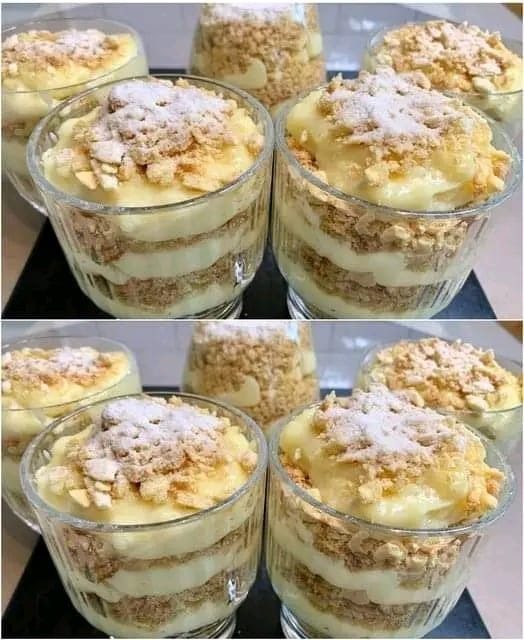ADVERTISEMENT
**Napoleon in a Glass: Finger-Licking Good, Eaten in 2 Minutes**
When it comes to indulgent desserts, few can compare to the grandeur and irresistible flavor of the iconic Napoleon pastry. Known for its delicate layers of flaky puff pastry, creamy custard, and a dusting of powdered sugar, Napoleon (or mille-feuille, as it is traditionally known in French) has been a staple in European pastry shops for centuries. But what if you could enjoy the decadent, rich, and delightful experience of Napoleon in a new, modern form—one that’s quick, easy to prepare, and just as delicious? Enter the innovative dessert: *Napoleon in a Glass*.
This dessert is the perfect fusion of a classic pastry and a quick, no-bake treat that can be made in a fraction of the time it takes to prepare a traditional Napoleon. It’s finger-licking good, visually stunning, and incredibly easy to eat in just a few minutes—without the fuss of layering, baking, or waiting for hours. Imagine all the elements you love about the Napoleon pastry: the crispy layers of puff pastry, the silky custard, and the sweet finish, but served in a glass, ready to be devoured in less than 2 minutes.
In this article, we’ll take a deep dive into how to make this delightful dessert, its variations, the tips and tricks for the perfect *Napoleon in a Glass*, and its history. Whether you’re hosting a dinner party, treating yourself, or impressing your guests, this dessert is guaranteed to satisfy your sweet tooth. Let’s explore why *Napoleon in a Glass* has become such a finger-licking good option in the world of desserts.
### The History of Napoleon Pastry
Before we dive into the recipe itself, let’s take a quick trip down memory lane and learn a bit about the Napoleon pastry, its origins, and why it’s so beloved.
Napoleon, also known as mille-feuille (French for “thousand leaves”), is a classic French dessert made from alternating layers of puff pastry and creamy filling, often pastry cream. The dessert is believed to have been named after Napoleon Bonaparte, though there is no historical evidence linking the pastry to the famous French emperor. Instead, it’s thought to have originated in the 17th century in France and evolved through the years, becoming popular across Europe, with slight variations depending on the region.
The traditional preparation of a Napoleon pastry can be time-consuming. It involves baking puff pastry until golden and crispy, making the custard or pastry cream filling, and then carefully layering these components to form a multi-layered, tall pastry. The top of the pastry is often adorned with a thin layer of fondant or icing and decorative lines, making it as visually appealing as it is delicious.
While the original Napoleon requires several steps and hours of work, *Napoleon in a Glass* offers a shortcut to experiencing all the beloved flavors and textures of this classic pastry in a matter of minutes.
### What Is *Napoleon in a Glass*?
*Napoleon in a Glass* is a deconstructed version of the traditional Napoleon pastry. Rather than assembling layers of puff pastry and custard in a complex, time-consuming fashion, this dessert is served in a glass, making it the perfect quick treat when you want the luxurious experience of a Napoleon without the laborious preparation. In essence, it is a layered dessert that captures the essence of the traditional Napoleon pastry—flaky, creamy, and sweet—without the need for baking.
What makes *Napoleon in a Glass* stand out is its simplicity and versatility. The dessert can be assembled in no time, and it can be customized to suit your tastes and dietary preferences. You get the indulgence of the flaky pastry layers and the creamy custard filling, but in a portion-controlled, convenient form that can be enjoyed without the need for utensils (unless you prefer them!).
### The Core Components of *Napoleon in a Glass*
To recreate the magic of a traditional Napoleon in this new, glassed form, we need to focus on the three main components that make up the flavor and texture profile of the original pastry:
1. **Flaky Puff Pastry**
The hallmark of any Napoleon pastry is its layers of buttery, flaky puff pastry. In *Napoleon in a Glass*, we replicate this with pre-made puff pastry or even some quicker alternatives like store-bought puff pastry sheets that are broken into smaller pieces or mini puff pastry bites. These provide the crispy, crunchy texture that complements the creamy filling.
2. **Pastry Cream or Custard**
A rich, velvety pastry cream (or custard) is essential in making *Napoleon in a Glass* taste just like the traditional version. The custard filling, which is made from a combination of milk, sugar, eggs, cornstarch, and vanilla, gives the dessert its signature smooth and luscious texture. In some variations, you can use whipped cream or mascarpone cheese as a shortcut to simplify the filling.
3. **Sweet Topping**
To finish off the dessert, you’ll need a sweet topping. The traditional Napoleon often has a dusting of powdered sugar or a layer of fondant on top. For *Napoleon in a Glass*, you can use powdered sugar, a drizzle of caramel, chocolate shavings, or even some fresh fruit to add a pop of color and flavor.
### How to Make *Napoleon in a Glass* in Just 2 Minutes
The beauty of *Napoleon in a Glass* is its speed and simplicity. You can prepare and enjoy this delightful dessert in as little as 2 minutes, making it an excellent choice for spontaneous cravings or impressing your guests at a moment’s notice.
#### Ingredients:
– 1 sheet of puff pastry (store-bought)
– 1 cup of pastry cream (homemade or store-bought)
– 2 tablespoons powdered sugar (for dusting)
– Optional: fresh berries or chocolate shavings for garnish
For Complete Cooking STEPS Please Head On Over To Next Page Or Open button (>) and don’t forget to SHARE with your Facebook friends
